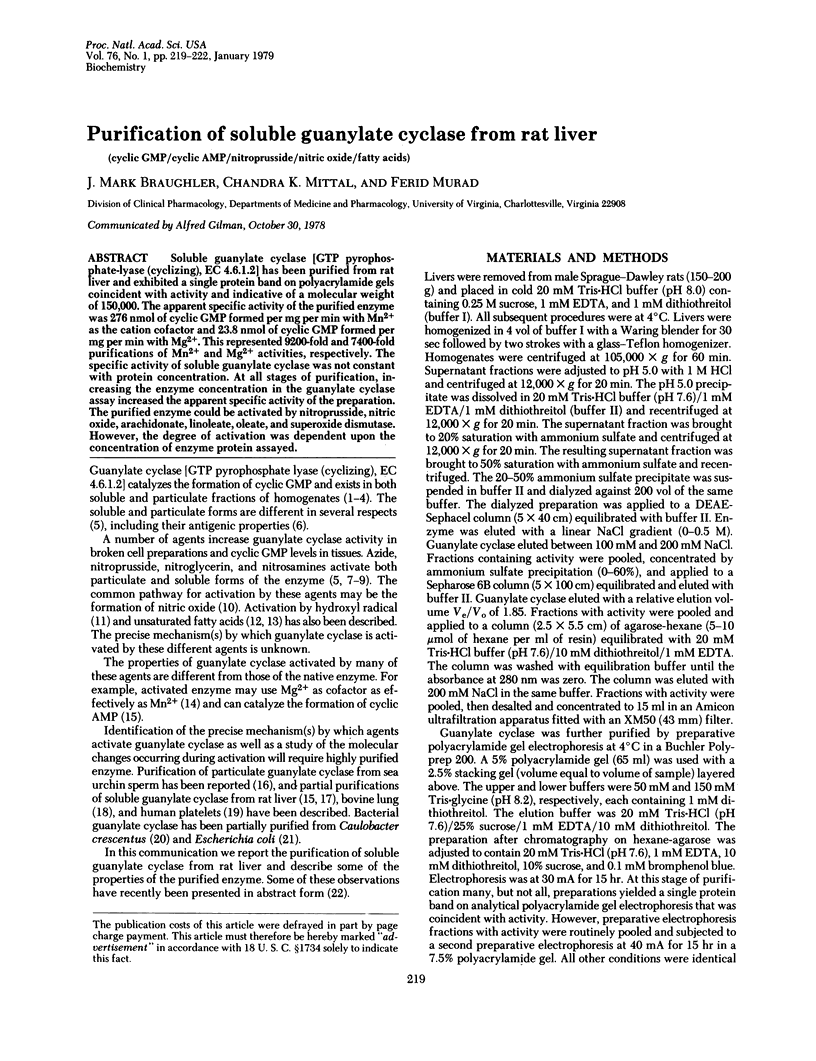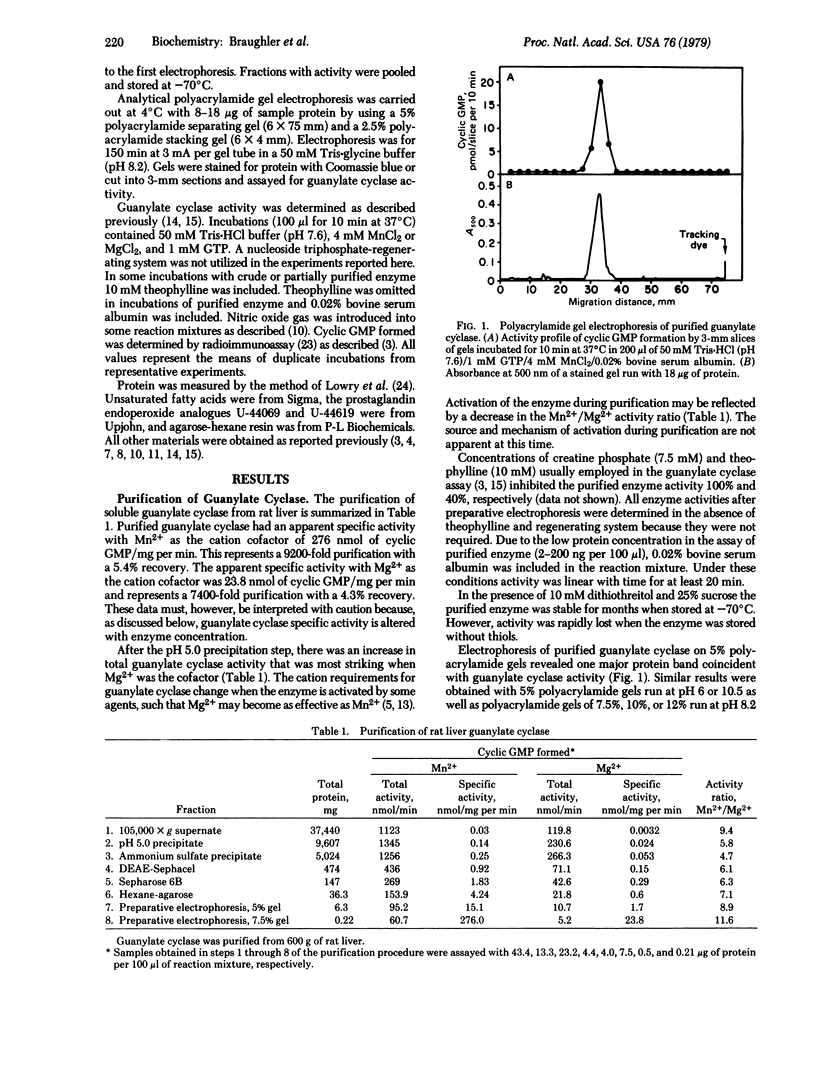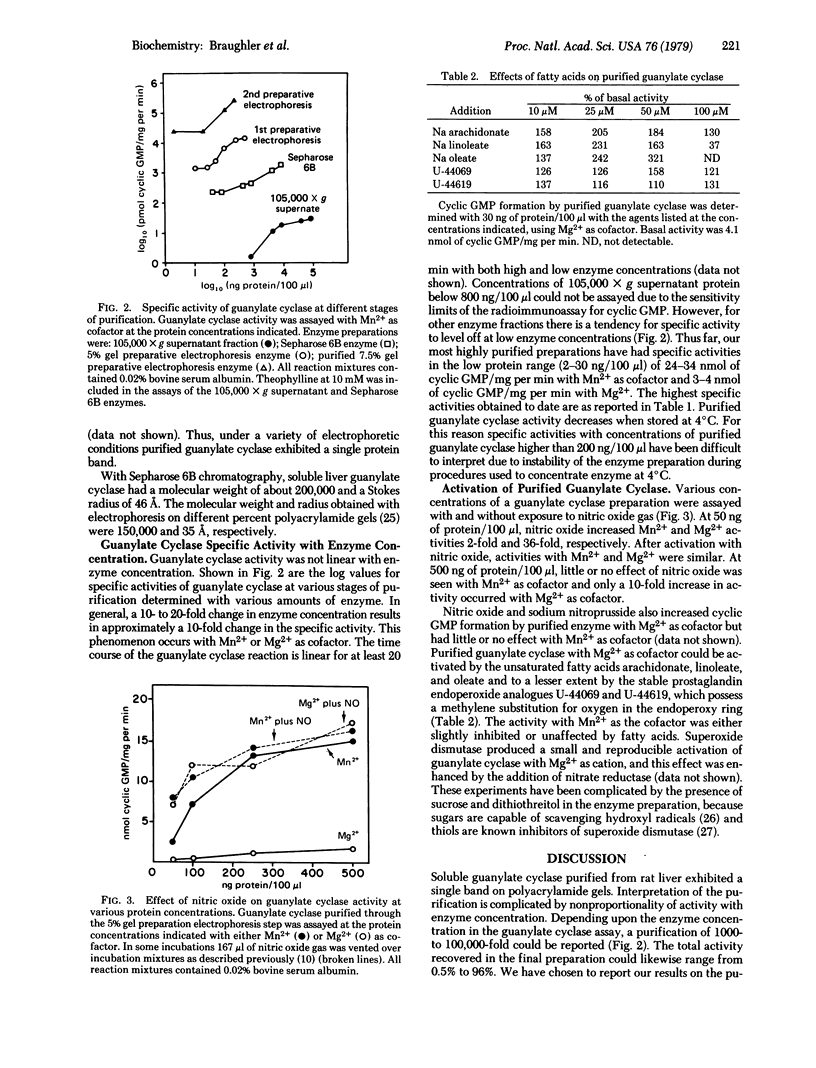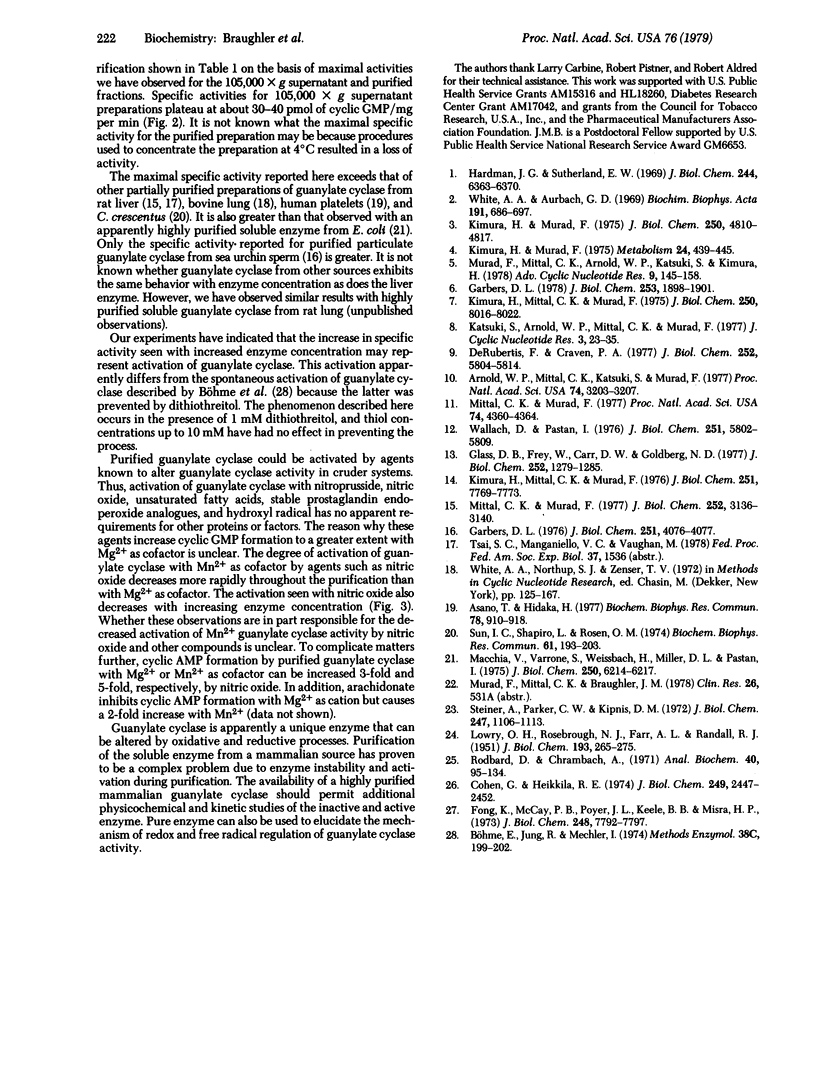Abstract
Soluble guanylate cyclase [GTP pyrophosphate-lyase (cyclizing), EC 4.6.1.2] has been purified from rat liver and exhibited a single protein band on polyacrylamide gels coincident with activity and indicative of a molecular weight of 150,000. The apparent specific activity of the purified enzyme was 276 nmol of cyclic GMP formed per mg per min with Mn2+ as the cation cofactor and 23.8 nmol of cyclic GMP formed per mg per min with Mg2+. This represented 9200-fold and 7400-fold purifications of Mn2+ and Mg2+ activities, respectively. The specific activity of soluble guanylate cyclase was not constant with protein concentration. At all stages of purification, increasing the enzyme concentration in the guanylate cyclase assay increased the apparent specific activity of the preparation. The purified enzyme could be activated by nitroprusside, nitric oxide, arachidonate, linoleate, oleate, and superoxide dismutase. However, the degree of activation was dependent upon the concentration of enzyme protein assayed.
Keywords: cyclic GMP, cyclic AMP, nitroprusside, nitric oxide, fatty acids
Full text
PDF



Selected References
These references are in PubMed. This may not be the complete list of references from this article.
- Arnold W. P., Mittal C. K., Katsuki S., Murad F. Nitric oxide activates guanylate cyclase and increases guanosine 3':5'-cyclic monophosphate levels in various tissue preparations. Proc Natl Acad Sci U S A. 1977 Aug;74(8):3203–3207. doi: 10.1073/pnas.74.8.3203. [DOI] [PMC free article] [PubMed] [Google Scholar]
- Asano T., Hidaka H. Purification of guanylate cyclase from human platelets and effect of arachidonic acid peroxide. Biochem Biophys Res Commun. 1977 Oct 10;78(3):910–918. doi: 10.1016/0006-291x(77)90509-5. [DOI] [PubMed] [Google Scholar]
- Böhme E., Jung R., Mechler I. Guanylate cyclase in human platelets. Methods Enzymol. 1974;38:199–202. doi: 10.1016/0076-6879(74)38032-9. [DOI] [PubMed] [Google Scholar]
- Cohen G., Heikkila R. E. The generation of hydrogen peroxide, superoxide radical, and hydroxyl radical by 6-hydroxydopamine, dialuric acid, and related cytotoxic agents. J Biol Chem. 1974 Apr 25;249(8):2447–2452. [PubMed] [Google Scholar]
- DeRubertis F. R., Craven P. A. Activation of hepatic guanylate cyclase by N-methyl-N'-nitro-N-nitrosoguanidine. Effects of thiols, N-ethylmaleimide, and divalent cations. J Biol Chem. 1977 Aug 25;252(16):5804–5814. [PubMed] [Google Scholar]
- Fong K. L., McCay P. B., Poyer J. L., Keele B. B., Misra H. Evidence that peroxidation of lysosomal membranes is initiated by hydroxyl free radicals produced during flavin enzyme activity. J Biol Chem. 1973 Nov 25;248(22):7792–7797. [PubMed] [Google Scholar]
- Garbers D. L. Sea urchin sperm guanylate cyclase antibody. Cross-reactivity various rat tissue guanylate cyclases. J Biol Chem. 1978 Mar 25;253(6):1898–1901. [PubMed] [Google Scholar]
- Garbers D. L. Sea urchin sperm guanylate cyclase. Purification and loss of cooperativity. J Biol Chem. 1976 Jul 10;251(13):4071–4077. [PubMed] [Google Scholar]
- Glass D. B., Frey W., 2nd, Carr D. W., Goldberg N. D. Stimulation of human platelet guanylate cyclase by fatty acids. J Biol Chem. 1977 Feb 25;252(4):1279–1285. [PubMed] [Google Scholar]
- Hardman J. G., Sutherland E. W. Guanyl cyclase, an enzyme catalyzing the formation of guanosine 3',5'-monophosphate from guanosine trihosphate. J Biol Chem. 1969 Dec 10;244(23):6363–6370. [PubMed] [Google Scholar]
- Katsuki S., Arnold W., Mittal C., Murad F. Stimulation of guanylate cyclase by sodium nitroprusside, nitroglycerin and nitric oxide in various tissue preparations and comparison to the effects of sodium azide and hydroxylamine. J Cyclic Nucleotide Res. 1977 Feb;3(1):23–35. [PubMed] [Google Scholar]
- Kimura H., Mittal C. K., Murad F. Activation of guanylate cyclase from rat liver and other tissues by sodium azide. J Biol Chem. 1975 Oct 25;250(20):8016–8022. [PubMed] [Google Scholar]
- Kimura H., Mittal C. K., Murad F. Appearance of magnesium guanylate cyclase activity in rat liver with sodium azide activation. J Biol Chem. 1976 Dec 25;251(24):7769–7773. [PubMed] [Google Scholar]
- Kimura H., Murad F. Localization of particulate guanylate cyclase in plasma membranes and microsomes of rat liver. J Biol Chem. 1975 Jun 25;250(12):4810–4817. [PubMed] [Google Scholar]
- Kimura H., Murad F. Two forms of guanylate cyclase in mammalian tissues and possible mechanisms for their regulation. Metabolism. 1975 Mar;24(3):439–445. doi: 10.1016/0026-0495(75)90123-7. [DOI] [PubMed] [Google Scholar]
- LOWRY O. H., ROSEBROUGH N. J., FARR A. L., RANDALL R. J. Protein measurement with the Folin phenol reagent. J Biol Chem. 1951 Nov;193(1):265–275. [PubMed] [Google Scholar]
- Macchia V., Varrone S., Weissbach H., Miller D. L. Guanylate cyclase in Escherichia coli. Purification and properties. J Biol Chem. 1975 Aug 25;250(16):6214–6217. [PubMed] [Google Scholar]
- Mittal C. K., Murad F. Activation of guanylate cyclase by superoxide dismutase and hydroxyl radical: a physiological regulator of guanosine 3',5'-monophosphate formation. Proc Natl Acad Sci U S A. 1977 Oct;74(10):4360–4364. doi: 10.1073/pnas.74.10.4360. [DOI] [PMC free article] [PubMed] [Google Scholar]
- Mittal C. K., Murad F. Formation of adenosine 3':5'-monophosphate by preparations of guanylate cyclase from rat liver and other tissues. J Biol Chem. 1977 May 25;252(10):3136–3140. [PubMed] [Google Scholar]
- Murad F., Mittal C. K., Arnold W. P., Katsuki S., Kimura H. Guanylate cyclase: activation by azide, nitro compounds, nitric oxide, and hydroxyl radical and inhibition by hemoglobin and myoglobin. Adv Cyclic Nucleotide Res. 1978;9:145–158. [PubMed] [Google Scholar]
- Rodbard D., Chrambach A. Estimation of molecular radius, free mobility, and valence using polyacylamide gel electrophoresis. Anal Biochem. 1971 Mar;40(1):95–134. doi: 10.1016/0003-2697(71)90086-8. [DOI] [PubMed] [Google Scholar]
- Steiner A. L., Parker C. W., Kipnis D. M. Radioimmunoassay for cyclic nucleotides. I. Preparation of antibodies and iodinated cyclic nucleotides. J Biol Chem. 1972 Feb 25;247(4):1106–1113. [PubMed] [Google Scholar]
- Sun I. C., Shapiro L., Rosen O. M. Purification and characterization of guanylate cyclase from Caulobacter crescentus. Biochem Biophys Res Commun. 1974 Nov 6;61(1):193–203. doi: 10.1016/0006-291x(74)90552-x. [DOI] [PubMed] [Google Scholar]
- Wallach D., Pastan I. Stimulation of guanylate cyclase of fibroblasts by free fatty acids. J Biol Chem. 1976 Sep 25;251(18):5802–5809. [PubMed] [Google Scholar]
- White A. A., Aurbach G. D. Detection of guanyl cyclase in mammalian tissues. Biochim Biophys Acta. 1969;191(3):686–697. doi: 10.1016/0005-2744(69)90362-3. [DOI] [PubMed] [Google Scholar]


